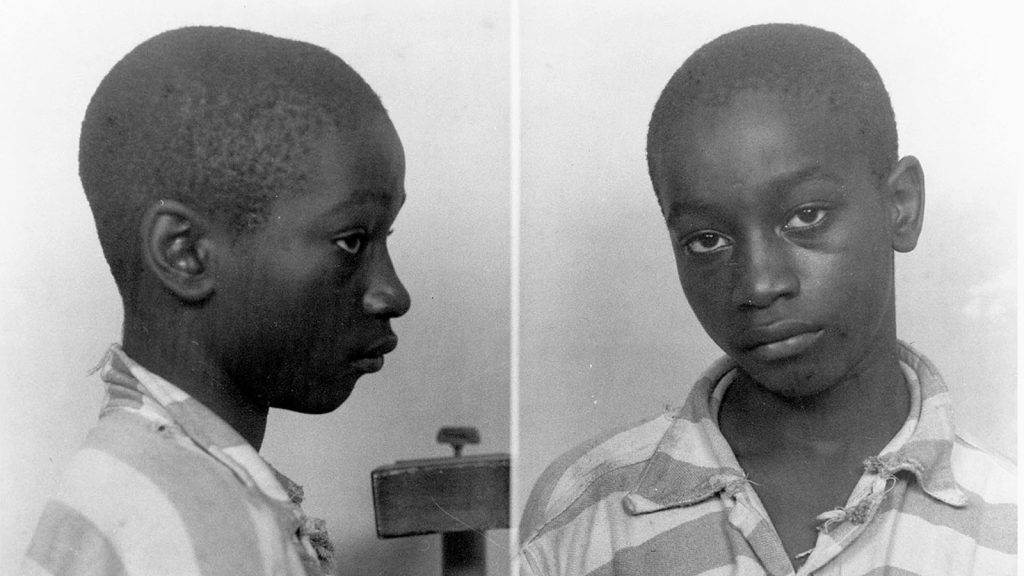
June 16, 1944 was execution day at the Central Correctional Institution in Columbia, and next on the docket to confront the electrical chair was George Stinney, a 14-year-old African American boy from Acolu, South Carolina. George weighed merely 95 pounds and stood at only 5” 1′ at the time he was strapped to an electric chair too big for his physique.1 Due to George’s small physique, extra holes needed to be punched into the chair’s leather bindings before the bindings could fit onto George’s limbs. This extra step bought George a couple extra minutes of life before he faced the electric chair.2 What was 14-year-old George Stinney thinking about right before execution? Surely not that he would soon become the youngest person executed in the 20th century.3

On March 24, 1944, tragedy and injustice came strolling into the small segregated lumber mill town of Alcolu, South Carolina. Betty June Binnicker, 11, and Mary Emma Thames, 7, were walking with their bike when they came across Aime Stinney Ruffner and George Stinney. The girls asked Aime and George whether or not they knew where they could find Maypops. Aime and George responded with a “no” and the girls went on their way. The night of March 24, Betty and Mary were reported missing after both girls failed to return home. The morning after, Betty June Binnicker and Mary Emma Thames were found dead in a ditch with their bikes laying on top of them. Police arrived at the Stinney household and arrested George, a 14-year-old African American boy, for the murders on Betty June Binnicker and Mary Emma Thames.4 Unfortunately, at the time police arrested George, the 1966 Supreme Court ruling on Miranda v. Arizona, which requires law enforcement officials to advise suspects of their rights, had not been ruled yet.5 After the police arrested and interrogated George without any access to his parents nor to an attorney, George confessed to the murders of Betty Binnicker and Mary Thame.6 George Stinney was not the only party impacted as a result of the murders, the Stinney family was persecuted by the rest of the town due the accusation against George. George Stinney Sr. was fired from work and the entire family was forced to permanently leave Acolu and move to Pinewood where the grandmother resided. Aime Stinney Ruffner stated, “We had no choice, the crowd came and they said they were going to get us.”7
The judge presiding over the case appointed Charles Plowden, 31-year-old local lawyer and aspiring politician, to represent George Stinney during the trial. On April 24, 1944, residents of Alcolu packed the local courthouse hoping justice would be served swiftly. A jury composed of 12 white men would be destined to determine George Stinney’s fate.8 Plowden failed to motion for a change of venue, which is a motion to change the location of a trial to overcome local prejudice. Stinney could have had a less partial jury in a different location. The prosecution’s case relied on the testimony of two police officers giving an account of Stinney’s confession he made during his interrogation. According to the police, Stinney confessed to having followed Betty Binnicker and Mary Thames after initially making contact with the girls, then unsuccessfully attempted to rape Betty, and then proceeded to beat both Betty and Mary with a railroad spike that had been laying around. The prosecution presented Stinney’s birth certificate as the last piece of evidence. The prosecution presented the birth certificate to make the case that Stinney was born on October 21, 1921, making him 14 years of age, which was traditionally the accepted age of criminal responsibility at the time.9 Plowden failed to cross-examine the prosecution’s witnesses, call forth any witness that could have corroborated with Stinney’s alibi, question the circumstances under which the police obtained the confession, nor to point out the lack of physical evidence, nor to point out the impracticality of a 14-year-old boy weighing 95 pounds and standing at 5 feet and 1 inch of physically being able to murder two girls, and finally failed to file an appeal. Plowden’s only defense comprised of the defendant being too young to be held responsible for the crimes he committed. Stinney’s trial, that would determine whether he lived or died, lasted a total of 3 hours. The judge sentenced the jury to deliberation, and 10 minutes later the jury comprised of 12 white men, found 14 year old George Stinney guilty of the murders of Betty June Binnicker and Mary Emma Thames. The judge sentenced George Stinney to death by electrocution. On June 16, 1944, the 2,400 volts of electricity passing through George Stinney rendered his body lifeless.10

70 years after the execution of George Stinney, Stinney’s three remaining siblings are seeking justice of their own with the help of a group of lawyers and civil rights advocates determined to exonerate Stinney. Stinney’s prosecution combined unconstitutional errors with serious misconduct. The team of attorneys argued in the Sumter County Courthouse that Stinney’s verdict was solely based on a coerced confession, therefore, the verdict should be thrown out.11 Due to new testimony, Stinney’s family, along with the team of attorneys, are hoping Judge Carmen T. Mullen, of the Fourteenth Circuit Court in South Carolina, rules in their favor. Despite most of the evidence, including Stinney’s confession and the transcript of the trial disappeared, Mullen heard new testimony from Stinney’s brothers and sisters, a witness from the search party, a child forensic psychiatrist, and a statement from Wilford Hunter, Stinney’s former cellmate.12 Frankie Bailey Dyches, the niece of one of the victims, stated, “He (George Stinney) was tried, found guilty by the laws of 1944, which are completely different now—it can’t be compared— and I think that it needs to be left as is.”13 Circuit Judge Carmen Mullen makes an important distinction in the Stinney case by stating that her task is not deciding whether Stinney is guilty or innocent, but rather to decide whether or not Stinney received a fair trial. On December 10, 2014, Circuit Judge Carmen Mullen vacated George Stinney’s conviction. Mullen ruled that Stinney’s confession was likely coerced and therefore inadmissible, “due to the power differential between his position as a 14-year-old black male apprehended and questioned by white, uniformed law enforcement in a small, segregated mill town in South Carolina.”14
George Stinney was tried, convicted of murdering two young White girls, and sentenced to death by electrocution, all in a single afternoon. The story of George Stinney showcases the irreversible actions that occur in a flawed criminal justice system that implements the death penalty primarily against minorities. The court system failed to provide George Stinney with a fair and impartial trial in 1944. As a result, George Stinney paid the ultimate price, death. 70 years after the death of Stinney, the Fourteenth Circuit Court in South Carolina ruled justly by vacating Stinney’s conviction. That moment on June 16, 1944 when 2,400 volts of electricity passed through Stinney’s body, it rendered him lifeless. The death of George Stinney sealed his fate in history as the youngest person executed in the 20th century. The finality of the death penalty by definition continues to risk the loss of innocents’ lives.
Warning: the video linked below is a very realistic, violent, and disturbing set of images of what the suffering and execution must have felt to young George Stinney Jr.
- Elaine Aradillas, Jill Smolowe, Howard Breuer, Michelle Boudin, “A Family’s Quest for Justice Wrongfully Executed,”(People, March, 2014), 73. ↵
- Charles Kelly, “Next Stop, Eternity,” (Life Rich Publishing, April 27, 2016), …. ↵
- Jesse Wegman, “A Boy’s Execution, 70 Years Later,” (New York: New York Times, June, 2014), 8. ↵
- Elaine Aradillas, Jill Smolowe, Howard Breuer, Michelle Boudin, “A Family’s Quest for Justice Wrongfully Executed,”(People, March, 2014), 75. ↵
- Miranda v. Arizona, 384 US 436 (1966). ↵
- Elaine Aradillas, Jill Smolowe, Howard Breuer, Michelle Boudin, “A Family’s Quest for Justice Wrongfully Executed,”(People, March, 2014), 75. ↵
- Elaine Aradillas, Jill Smolowe, Howard Breuer, Michelle Boudin, “A Family’s Quest for Justice Wrongfully Executed,”(People, March, 2014), 74. ↵
- Mark Kantrowitz, “The Killing of George Stinney Jr.,”(Rhode Island: Rhode Island Lawyers Weekly, 2018). ↵
- David Bruck, “Executing Teen Killers Again,” (The Washington Post, September 15, 1985). ↵
- Mark Kantrowitz, “The Killing of George Stinney Jr.,”(Rhode Island: Rhode Island Lawyers Weekly, 2018). ↵
- Jesse Wegman, “George Stinney was Executed at 14,” (New York: New York Times, January 12, 2015), 9. ↵
- Lindsey Beaver, “It took 10 minutes to convict 14-year-old George Stinney Jr. It took 70 years after his execution to exonerate him,” (The Washington Post, December 18, 2014). ↵
- Jesse Wegman, “George Stinney was Executed at 14,” (New York: New York Times, January 12, 2015), 8. ↵
- Brad Knickerbocker, “Executed at Age 14, George Stinney Exonerated 70 Years Later,”(Christian Science Monitor, December, 2014). ↵



97 comments
Kathryn Martinez
This case is so heartbreaking. Even 70 years later the judge did not declare Stinney “innocent” or exonerate him in 2014; she overturned his conviction on the basis that his trial and execution violated his constitutional due process rights. There is no forensic evidence to which base this case off of. All we have is evidence of bias and deep southern racism. To think that if only he had lived in a different time perhaps he would still be alive.
Patricia Arechiga
By fart the most heartbreaking article I have yet to read. It is so upsetting to see a young child found guilty without any legit evidence. It is pretty safe to say that the confession might have been false or twisted around to find George guilty. What really got to me was the amount of ‘illegality’ there was in the trial. It is so unfortunate that George was practically alone when at the police station. No 14 year old boy knows their rights or what to do (since rights being read at the time wasn’t mandatory). The amount of discrimination that there was in the country at the time, and sadly still today, creates a world of abuse in power, especially when it comes to social justice. Such good research conducted to create a very good narrative to follow! So glad I came across this article.
Priscilla Poorbaugh
Being black in a southern state in the 40’s instantly puts a target on your back. Whether George committed the act or not, as a US citizen, he should have had to right to a fair trial. The jury really took only three hours to give a 14 year old boy the death penalty. Is that not cruel and unusual punishment for a child? I also know that our laws now are not the same as they were in the 40’s, however I believe the moral of this article is the shed light on how unjust the system was to African Americans during this time, no matter the age.
Roberto Rodriguez
From the article’s title to the fantastic introduction I was immediately hooked and eventually engrossed entirely in the story (absolutely amazing story telling). I think that it is just crazy to think in what world is a 14 year old criminally responsible. That is not to say that 14 year olds should not be accountable for their actions, but just thinking now of juvie and all of the behavioral correctional programs, just all of the second chances that troubled kids get now it is insane. This story is unfortunately eerily similar to that of Emmett Till (I would encourage anybody that thought that this story was impactful/moving to read about Emmet Till).
Felicia Stewart
This article was a very interesting read. I was not familiar, or had even heard of, this story prior to reading this article. It is very sad to read that a fourteen year old boy lost his life to the death penalty, especially in such a painful way as electrocution, for a crime he did not even commit. I believe this maybe why the death penalty is not as common anymore, as there are many times that new evidence comes about and people actually are not guilty for the crimes they commit, more so in the cases in which nearly no evidence is available.
Andrew Petri
This article is very interesting and talks about a case of injustice. Firstly, accusing a fourteen year old boy right off the bat is not a very thought out assumption. Secondly, though I fully support the death penalty, this case is not a very fair case because it was before the justice system had more regulations that gives the accused a better chance at a fair case.
Claudia Sanchez
A heartbreaking story of how flawed the judicial system was during those times. Whether or not he did the crime, he was not given a fair trial in the least. to be executed that same day is such a travesty. However, major fault on his lawyer at the time. It seems as though he did not even try to help his defendant.
Brianna Nevarez
It causes me great sorrow to read this article. I am shocked that this boy who did not hold the physical strength to be capable of murdering not one but two little girls was killed. He was executed as an innocent and I cannot help but think just how many people have been executed injustly because of racism and ignorance. What makes this story even worse is that this boy’s fate was decided in three hours. Three hours is not enough time to make a valid argument for or against a young boy. I believe he was executed because officials were just looking for somebody to blame. The real killer was roaming free while an innocent boy who had his whole life ahead of him had to see it cut short for a crime he did not commit. Ending this boy’s life so soon was the real crime here.
Maria Martinez
This story was truly heartbreaking to read, but what is more heartbreaking is that the kind of prejudice that led to his death at a young 14 years old is still very very present in today’s justice system. This “trial” occurred in 1944, and still this many years later there are so many(too many) young and old people of color who are wrongfully being tried and convicted of crimes that they did not commit or in other situations are tried and given extreme sentences while white people are given shorter not extreme sentences for the same crimes. While this topic is very controversial it is important to keep the conversation going and it is even more important for us as a society to learn and grow from such tragic events such as the killing of George Stinney.
Ruby Wynn
It is terrible that a 14-year-old boy could be executed. Even if he was executed, it should not have been by a painful method, like electrocution. He was not given a fair trial, and it is clear that those deciding whether he was guilty or innocent did not care about the truth of what happened, but were willing to coerce a confession and have a biased jury.